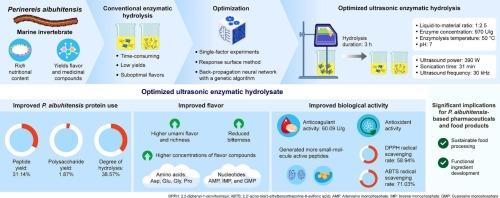Ultrasonic-assisted enzymatic hydrolysis of Perinereis aibuhitensis using the RSM–BP–GA model
IF 9.7
1区 化学
Q1 ACOUSTICS
引用次数: 0
Abstract
The lack of ultrasound-assisted hydrolysis techniques often limits the efficacy of Perinereis aibuhitensis protein hydrolysate. Therefore, using P. aibuhitensis as the raw material and a 1:1 mix of neutral protease and flavour protease as the composite enzyme, we evaluated the degree of hydrolysis (DH). We systematically optimised the conditions for ultrasound-assisted enzymatic hydrolysis of P. aibuhitensis proteins using single-factor experiments, the response surface method, and a back-propagation neural network integrated with a genetic algorithm. The optimal hydrolysis conditions were as follows: a liquid-to-material ratio, 1:2.5; enzyme concentration, 970 U/g; ultrasound power, 390 W; sonication time, 31 min; enzymolysis temperature, 50 °C; ultrasound frequency, 30 kHz; pH, 7; and hydrolysis duration, 3 h. Under these conditions, compared to non-ultrasound composite protease hydrolysis, the flavour of P. aibuhitensis ultrasound-assisted enzymatic hydrolysate significantly improved (umami and richness enhanced, bitterness and bitter aftertaste reduced). Anticoagulant activity, DPPH and ABTS radical scavenging rates reached 60.09 U/g, 58.94 %, and 71.03 %, increasing by 0.26-, 0.10-, and 0.15-fold, respectively, potentially due to the increased content of flavour compounds. Specifically, Asp, Glu, Gly, Pro, AMP, IMP, and GMP concentrations increased by 0.18-, 0.15-, 0.15-, 0.23–, 0.27-, 0.13-, and 0.27-fold, respectively. Moreover, P. aibuhitensis peptide yield reached 31.14 % (0.24-fold increase), generating more small-molecule active peptides. Polysaccharide yield reached 1.87 % (0.23-fold increase), and the DH reached 38.57 % (0.50-fold increase). Reaction time was reduced by 29 min compared to that using other methods. Overall, this study provides a robust theoretical foundation for developing P. aibuhitensis-based food products and pharmaceuticals.

基于RSM-BP-GA模型的超声辅助酶解aibuhitperinreis。
超声辅助水解技术的缺乏往往限制了aibuhitensis蛋白水解产物的功效。因此,我们以aibuhitensis为原料,以中性蛋白酶和风味蛋白酶的1:1混合为复合酶,对其水解度(DH)进行了评价。采用单因素实验、响应面法和结合遗传算法的反向传播神经网络对超声辅助酶解p.a aibuhitensis蛋白的条件进行了系统优化。最佳水解条件为液料比1:25 .5;酶浓度,970 U/g;超声功率390 W;超声时间,31分钟;酶解温度,50℃;超声波频率:30 kHz;pH值,7;在这些条件下,与非超声复合蛋白酶水解相比,超声辅助酶解产物的风味显著改善(鲜味和丰富度增强,苦味和苦味降低)。抗凝血活性、DPPH和ABTS自由基清除率分别达到60.09 U/g、58.94%和71.03%,分别提高了0.26倍、0.10倍和0.15倍,这可能与风味化合物含量的增加有关。具体来说,Asp、Glu、Gly、Pro、AMP、IMP和GMP浓度分别增加了0.18-、0.15-、0.15-、0.23-、0.27-、0.13-和0.27倍。此外,P. aibuhitensis的肽产量达到31.14%,增加了0.24倍,产生了更多的小分子活性肽。多糖得率达到1.87%(提高0.23倍),DH达到38.57%(提高0.50倍)。与其他方法相比,反应时间缩短29 min。总之,本研究为开发aibuhitensis为原料的食品和药品提供了坚实的理论基础。
本文章由计算机程序翻译,如有差异,请以英文原文为准。
求助全文
约1分钟内获得全文
求助全文
来源期刊

Ultrasonics Sonochemistry
化学-化学综合
CiteScore
15.80
自引率
11.90%
发文量
361
审稿时长
59 days
期刊介绍:
Ultrasonics Sonochemistry stands as a premier international journal dedicated to the publication of high-quality research articles primarily focusing on chemical reactions and reactors induced by ultrasonic waves, known as sonochemistry. Beyond chemical reactions, the journal also welcomes contributions related to cavitation-induced events and processing, including sonoluminescence, and the transformation of materials on chemical, physical, and biological levels.
Since its inception in 1994, Ultrasonics Sonochemistry has consistently maintained a top ranking in the "Acoustics" category, reflecting its esteemed reputation in the field. The journal publishes exceptional papers covering various areas of ultrasonics and sonochemistry. Its contributions are highly regarded by both academia and industry stakeholders, demonstrating its relevance and impact in advancing research and innovation.
 求助内容:
求助内容: 应助结果提醒方式:
应助结果提醒方式:


